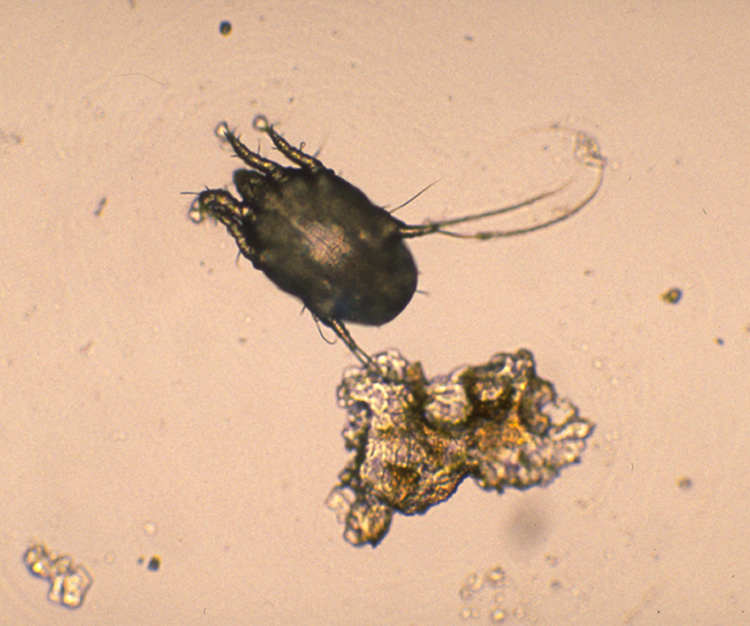Otodectes disease
Introduction
- Cause: ear mite, Otodectes cynotis.
- Signs: pruritic ears, red-brown otic discharge, generalized skin disease.
- Diagnosis: ear swab and microscopy, direct visualization.
- Treatment: otic parasiticides, whole body insecticides, ivermectin, treat all in-contact pets.
- Prognosis: good.
Presenting signs
- Pruritic dermatitis.
Age predisposition
- Younger animals.
Pathogenesis
Etiology
- O. cynotis Otodectes cynotis.
Specific
- Contact with carrier animals.
Pathophysiology
- Ear mites
 feed on epidermal debris → irritates ear canal → cerumen, blood and mite exudate accumulates.
feed on epidermal debris → irritates ear canal → cerumen, blood and mite exudate accumulates. - Mites on other parts of the body (neck, rump, tail) → feed → pruritic dermatitis in some animals.
- Immediate hypersensitivity reaction may occur.
Timecourse
- Variable.
Epidemiology
- O. cynotis is a non-host specific, surface living, large, white, freely moving mite.
- Eggs have a four-day incubation, adults a two month lifespan; the lifecycle lasts three weeks.
Diagnosis
Subscribe To View
This article is available to subscribers.
Try a free trial today or contact us for more information.
Treatment
Subscribe To View
This article is available to subscribers.
Try a free trial today or contact us for more information.
Prevention
Subscribe To View
This article is available to subscribers.
Try a free trial today or contact us for more information.
Outcomes
Subscribe To View
This article is available to subscribers.
Try a free trial today or contact us for more information.
Further Reading
Publications
Refereed papers
- Recent references from VetMed Resource and PubMed.
- Sotiraki S T, Koutinas A F, Leontides L S et al (2001) Factors affecting the frequency of ear canal and face infestation by Otodectes in the cat. Vet Parasitol 96 (4), 309-315 PubMed.
- Engelen M A & Anthonissens E (2000) Efficacy on non-acaricidal containing otic preparations in the treatment of otoacariasis in dogs and cats. Vet Rec 147 (20), 567-569 PubMed.
- Shanks D J, McTier T L, Rowan T G et al (2000) The efficacy of selamectin in the treatment of naturally acquired aural infestation otodectes cynotis on dogs and cats. Vet Parasitol 91 (3-4), 283-290 PubMed.
- Six R H, Clemence R G, Thomas C A et al (2000) Efficacy and safety of selamectin against Sarcoptes scabiei on dogs and Otodectes cynotis on dogs and cats presented as veterinary patients. Vet Parasitol 91 (3-4), 291-309 PubMed.
- Song M D (1991) Using Ivermectin to treat feline dermatosis caused by external parasites. Vet Med 86 (5), 498-502 AGRIS FAO.
- Powell M B, Weisbroth S H, Roth L et al (1980) Reaginic hypersensitivity in Otodectes cynotis infestation of cats and mode of mite feeding. Am J Vet Res 41 (6), 877-82 PubMed.
Other sources of information
- Miller W H, Griffin C E & Campbell K L (2013) Muller and Kirk's Small Animal Dermatology. 7th edn. Philadelphia: W B Saunders. pp 298-300 (detailed dermatology textbook for in-depth reading).